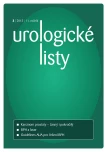ENDOMETRIOSIS OF THE UROGENITAL TRACT
Authors:
J. Klečka; P. Klézl; V. Mašková; R. Grill
Published in:
Urol List 2013; 11(3): 40-42
Overview
Authors in submitted text report five patients diagnosed with endometriosis of the urinary tract. In four patients we observed involvement of the bladder, in one patient localization of the left ureter. The authors point out necessity of thorough examination and evaluation of nonspecific symptoms that are typical of endometriosis of the urinary tract. Gold standard of treatment is surgical treatment, which is followed in the case of recurrence by castration therapy by either danazol or LHRH administration.
Key words:
endometriosis, transurethral resection, danazol, LHRH
Sources
1. Westney OL, Amundsen CL, Mc Guire EJ. Bladder endometritis: Conservative management. J Urol 2000; 163: 1814–1817.
2. Shook TE, Nyberg LM. Endometriosis of the urinary tract. Urology 1988; 31: 1–6.
3. Bologna RA, Whitmore KE. Genitourinary endometritis. AUA Update Series 2001; 1: 21.
4. Donnez J, Spada F, Squifflet J et al. Bladder endometritis must be considered as bladder adenomyosis. Fertil Steril 2000; 74: 1175–1181.
5. Ridley JH. The validity of Sampson´s theory of endometritis. Am J Obstet Gynecol 1961; 82: 777–782.
6. Batler RA, Kim SC, Nadler RB. Bladder endometritis : Pertinent clinical images. Urology 2001; 57: 798–799.
7. Stillwell TJ, Kramer SA, Lee RA. Endometriosis of the ureter. Urology 1986; 28: 81–85.
8. Fedel L, Bianchi S, Raffaelli R et al. Preoperative assessment of bladder endometritis. Hum Reprod 1997; 12: 2519–2522.
9. Nezhat CR, Nezhat FR. Laparoscopic segmental bladder resection for endometritis. Obstet Gynecol 1993; 81: 882–884.
Labels
Paediatric urologist UrologyArticle was published in
Urological Journal

2013 Issue 3
Most read in this issue
- ENDOMETRIOSIS OF THE UROGENITAL TRACT
- WHAT IS THE BENEFIT OF DENOSUMAB (XGEVA®) IN PATIENT WITH SOLID TUMOURS WITH BONE METASTASES?
- XTANDI (ENZALUTAMIDE): A NEW TREATMENT FOR METASTATIC CASTRATION-RESISTANT PROSTATE CANCER
- POST PROSTATECTOMY INCONTINENCE: A REVIEW OF CURRENT ASSESSMENT AND MANAGEMENT
